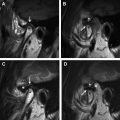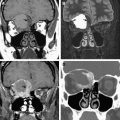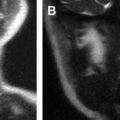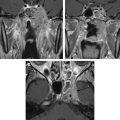This article addresses the clinical evaluation and some of the more common flaps and grafts used to reconstruct the surgical bed after excision of primary head and neck cancers and nodal metastases. This focused summary is intended to enhance the reader’s understanding and improve the interpretation of posttreatment MR imaging. A practical approach to MR imaging evaluation of the postoperative reconstructed neck is presented. Readers of this article will become familiar with the normal appearances of commonly used flaps, recognize common complications, be able to delineate residual and recurrent neoplasm, and learn to avoid interpretative pitfalls.
- •
The workhorse flaps used in oncologic head and neck reconstructions are vascularized tissues composed of skin, subcutaneous fat, and fascia, with or without muscle. These flaps are either pedicled or are revascularized free-tissue grafts by way of microvascular anastomoses.
- •
MR imaging appearance of a flap reflects its composition and the sequela of denervation or adjuvant chemoradiation.
- •
Flap failure is assessed clinically without the need for imaging evaluation.
- •
Neoplasms tend to recur at the interface of the free flap and the recipient surgical bed.
- •
The expected swelling and enhancement of a normal flap should not be mistaken for neoplasm.
Introduction
In the United States, the squamous cell carcinoma is the most common head and neck malignancy in adults with a reported incidence of 10.6 per 100,000 cases of oral cavity and pharyngeal cancer (2004–2008 combined years). Five-year relative survival rates of oral and pharyngeal cancer have improved to 65.1% (2001–2007 combined years) from 46% (1950–1954 combined years). Data extracted from the Surveillance, Epidemiology, and End Results database show no significant changes in overall relative survival of sinonasal malignancies; however, the best relative survival was noted in patients treated with surgery or a combination of surgery and radiotherapy. Given the spectrum of pathologies occurring in the head and neck, survival remains difficult to generalize. However, given medical advancements, the growing experience of multidisciplinary approaches to treating head and neck cancer, and the continued innovations in CT and MR imaging techniques, routine posttreatment imaging will become increasingly more common. Assessment for residual or recurrent tumor is the primary goal of follow-up imaging to guide management, monitor treatment response, and determine whether additional surgery or chemoradiation therapy is necessary. The altered anatomy from tumor resection and reconstruction of the surgical bed can present a challenge to the unfamiliar radiologist. It is paramount that normal reconstructive flaps and grafts not be mistaken for neoplasm. The wide range of flaps and grafts available reflects the individually tailored nature of each reconstruction. The best reconstruction is dictated by the surgeon’s experience and the patient’s anatomy to maximize the success of defect closure, functional restoration, and cosmesis while minimizing comorbidity. The workhorses for sizable and complex defect reconstruction in oncologic practice are the vascularized tissues including regional pedicled flaps and free-tissue transfer flaps. CT and especially MR imaging offer the advantage of excellent soft tissue definition, which is important in differentiating reconstructive flaps and grafts from neoplasm.
Important surgical anatomic considerations and flap terminology
Broadly speaking, the commonly used vascularized flaps include local-regional flaps and free flaps. The names of the flaps reflect their donor sites, tissue composition, and vascular supply. The local-regional flaps are harvested from the donor sites close to the defect with intact vascular pedicles. They are rotated and transposed to reach the defect for surgical closure. Therefore, the rotated flaps are technically limited by the pedicle vascular length and have to be free of tumor involvement and prior irradiation to ensure their tissue health. Free flaps are transferred from a donor site distant from the primary surgical bed, and the vessels of the flaps are transected and subsequently reanastomosed to available blood vessels in the recipient bed using microvascular surgical techniques. For head and neck reconstructions, vascular anastomoses are preferentially end-to-end but in some instances end-to-side, and typically use branches of the external carotid artery, such as the facial and superior thyroidal arteries and tributaries of internal jugular or external jugular veins. Less common but viable options for arterial anastomoses include the transverse cervical, superficial temporal, and lingual arteries. Flaps may contain skin paddle, subcutaneous fat, fascia, muscle, or bone. The term “composite flaps” refers to flaps having more than one tissue type, typically containing muscle and bone. For example, a fasciocutaneous flap contains skin, subcutaneous fat, and fascia; a myocutaneous flap contains skin, subcutaneous fat, and muscle; and an osteomyocutaneous flap is myocutaneous flap with an osseous component. There is a plethora of flap options and the commonly used flaps are summarized in Table 1 .








